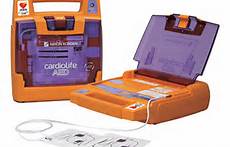Author:
|
Back to Blog
 American Heart Association CPR courses train rescuers to use an AED. The acronym “AED” stands for “Automated External Defibrillator.” An AED is used in conjunction with CPR, and it can increase the chances of survival when it is used very soon after cardiac arrest. Timing is important because the sooner the AED is used the better the chances of survival. The first thing the CPR rescuer does with an AED is turn it on. Once the AED is turned on it will detect the heart’s rhythm and determine whether the rhythm is “shockable” or “non-shockable.” If the rhythm is shockable then the AED will advise the CPR rescuer to stand clear while the AED charges. The AED then will tell the CPR rescuer to push the shock button. When the CPR rescuer pushes the shock button the standard adult AED administers 360 joules to the heart. The best case scenario is that the shock puts the heart back into a regular rhythm. After the shock, the AED will advise the rescuer to immediately resume CPR, starting with compressions. At that point the rescuer will continue to administer CPR while the AED keeps track of the time. After 2 minutes the AED will advise the rescuer to stop CPR and stand clear. The AED will then re-analyze the heart’s rhythm and the entire process will begin again. In the BLS Healthcare Provider American Heart Association CPR courses, the resucers are instructed to switch rescuers after every 5 sets of compressions. When the AED is available, CPR rescuers are instructed to switch every time the AED re-analyzes, which should be roughly 5 cycles. To learn more about AED or CPR give us a call (503) 538-2610 or www.cprnorthwest.com/
0 Comments
Read More
Your comment will be posted after it is approved.
Leave a Reply. |

 RSS Feed
RSS Feed